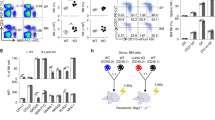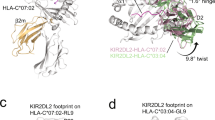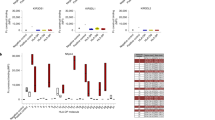Abstract
Natural killer (NK) cell function is negatively regulated by inhibitory receptors interacting with major histocompatibility complex class I molecules expressed on target cells. Here we show that the inhibitory Ly49A NK cell receptor not only binds to its H-2Dd ligand expressed on potential target cells (in trans) but also is constitutively associated with H-2Dd in cis (on the same cell). Cis association and trans interaction occur through the same binding site. Consequently, cis association restricts the number of Ly49A receptors available for binding of H-2Dd on target cells and reduces NK cell inhibition through Ly49A. By lowering the threshold at which NK cell activation exceeds NK cell inhibition, cis interaction allows optimal discrimination of normal and abnormal host cells.
This is a preview of subscription content, access via your institution
Access options
Subscribe to this journal
Receive 12 print issues and online access
$209.00 per year
only $17.42 per issue
Buy this article
- Purchase on Springer Link
- Instant access to full article PDF
Prices may be subject to local taxes which are calculated during checkout









Similar content being viewed by others
References
Arase, H., Mocarski, E.S., Campbell, A.E., Hill, A.B. & Lanier, L.L. Direct recognition of cytomegalovirus by activating and inhibitory NK cell receptors. Science 296, 1323–1326 (2002).
Smith, H.R. et al. Recognition of a virus-encoded ligand by a natural killer cell activation receptor. Proc. Natl. Acad. Sci. USA 99, 8826–8831 (2002).
Ljunggren, H.G. & Kärre, K. In search of the 'missing self': MHC molecules and NK cell recognition. Immunol. Today 11, 237–244 (1990).
Bauer, S. et al. Activation of NK cells and T cells by NKG2D, a receptor for stress-inducible MICA. Science 285, 727–729 (1999).
Karlhofer, F.M., Ribaudo, R.K. & Yokoyama, W.M. MHC class I alloantigen specificity of Ly-49+ IL-2 activated natural killer cells. Nature 358, 66–70 (1992).
Kärre, K. NK cells, MHC class I molecules and missing self. Scand. J. Immunol. 55, 221–228 (2002).
Colucci, F., DiSanto, J.P. & Leibson, P. Natural killer cell activation in mice and men: different triggers for similar weapons? Nat. Immunol. 3, 807–813 (2002).
Cerwenka, A. et al. Retinoic acid early inducible genes define a ligand family for the activating NKG2D receptor in mice. Immunity 12, 721–727 (2000).
Diefenbach, A., Jamieson, A.N., Liu, S., Shastri, N. & Raulet, D.H. Ligands for the murine NKG2D receptor: expression by tumor cells and activation of NK cells and macrophages. Nat. Immunol. 1, 95–97 (2000).
Diefenbach, A. & Raulet, D.H. Strategies for target cell recognition by natural killer cells. Immunol. Rev. 181, 170–184 (2001).
Kane, K. Ly-49 mediates EL4 lymphoma adhesion to isolated class I major histocompatibility complex molecules. J. Exp. Med. 179, 1011–1015 (1994).
Hanke, T. et al. Direct assessment of MHC class I binding by seven Ly49 inhibitory NK cell receptors. Immunity 11, 67–77 (1999).
Matsumoto, N., Ribaudo, R.K., Abastado, J.P., Margulies, D.H. & Yokoyama, W.M. The lectin-like NK cell receptor Ly-49A recognizes a carbohydrate-independent epitope on its MHC class I ligand. Immunity 8, 245–254 (1998).
Waldenström, M., Sundbäck, J., Olsson-Alheim, M.Y., Achour, A. & Kärre, K. Impaired MHC class I (H-2Dd)-mediated protection against Ly-49A+ NK cells after amino acid substitutions in the antigen binding cleft. Eur. J. Immunol. 28, 2872–2881 (1998).
Matsumoto, N., Mitsuki, M., Tajima, K., Yokoyama, W.M. & Yamamoto, K. The functional binding site for the C-type lectin-like natural killer cell receptor Ly49A spans three domains of its major histocompatibility complex class I ligand. J. Exp. Med. 193, 147–157 (2001).
Wang, J. et al. Binding of the natural killer cell inhibitory receptor Ly49A to its major histocompatibility complex class I ligand. J. Biol. Chem. 277, 1433–1442 (2002).
Karlhofer, F.M., Hunziker, R., Reichlin, A., Margulies, D.H. & Yokoyama, W.M. Host MHC class I molecules modulate in vivo expression of a NK cell receptor. J. Immunol. 153, 2407–2416 (1994).
Olsson, M.Y., Karre, K. & Sentman, C.L. Altered phenotype and function of natural killer cells expressing the major histocompatibility complex receptor Ly-49 in mice transgenic for its ligand. Proc. Natl. Acad. Sci. USA 92, 1649–1653 (1995).
Held, W., Dorfman, J.R., Wu, M.-F. & Raulet, D.H. Major histocompatibility complex class I dependent skewing of the natural killer cell Ly49 receptor repertoire. Eur. J. Immunol. 26, 2286–2292 (1996).
Kase, A., Johansson, M.H., Olsson-Alheim, M.Y., Kärre, K. & Höglund, P. External and internal calibration of the MHC class I-specific receptor Ly49A on murine natural killer cells. J. Immunol. 161, 6133–6138 (1998).
Sjöström, A. et al. Acquisition of external major histocompatibility complex class I molecules by natural killer cells expressing inhibitory Ly49 receptors. J. Exp. Med. 194, 1519–1530 (2001).
Zimmer, J., Ioannidis, V. & Held, W. H-2D ligand expression by Ly49A+ natural killer (NK) cells precludes ligand uptake from environmental cells: implications for NK cell function. J. Exp. Med. 194, 1531–1539 (2001).
Olsson-Alheim, M.Y., Salcedo, M., Ljunggren, H.-G., Kärre, K. & Sentman, C.L. NK cell receptor calibration. Effects of MHC class I induction on killing by Ly49Ahigh and Ly49Alow NK cells. J. Immunol. 159, 3189–3194 (1997).
Held, W., Cado, D. & Raulet, D.H. Transgenic expression of the Ly49A natural killer cell receptor confers class I major histocompatibility complex (MHC)-specific inhibition and prevents bone marrow allograft rejection. J. Exp. Med. 184, 2037–2041 (1996).
Ioannidis, V., Zimmer, J., Beermann, F. & Held, W. Cre recombinase-mediated inactivation of H-2Dd transgene expression: evidence for partial missing-self recognition by Ly49A NK cells. J. Immunol. 167, 6256–6262 (2001).
Johansson, M.H., Bieberich, C., Jay, G., Kärre, K. & Höglund, P. Natural killer cell tolerance in mice with mosaic expression of major histocompatibility complex class I molecules. J. Exp. Med. 186, 353–364 (1997).
Michaelsson, J., Achour, A., Rölle, A. & Kärre, K. MHC class I recognition by NK receptors in the Ly49 family is strongly influenced by the b2-microglobulin subunit. J. Immunol. 166, 7327–7334 (2001).
Held, W. & Raulet, D.H. Ly49A transgenic mice provide evidence for a major histocompatibility complex-dependent education process in natural killer cell development. J. Exp. Med. 185, 2079–2088 (1997).
Dorfman, J.R. & Raulet, D.H. Major histocompatibility complex genes determine natural killer cell tolerance. Eur. J. Immunol. 26, 151–155 (1996).
Moody, A.M. et al. Developmentally regulated glycosylation of the CD8αβ coreceptor stalk modulates ligand binding. Cell 107, 501–512 (2001).
Daniels, M.A. et al. CD8 binding to MHC class I molecules is influenced by T cell maturation and glyosylation. Immunity 15, 1051–1061 (2001).
Storkus, W.J., Zeh III, H.J., Salter, R.D. & Lotze, M.T. Identification of T-cell epitopes: rapid isolation of class I-presented peptides from viable cells by mild acid elution. J. Immunother. 14, 94–103 (1993).
Tormo, J., Natarajan, K., Margulies, D.H. & Mariuzza, R.A. Crystal structure of a lectin-like natural killer cell receptor bound to its MHC class I ligand. Nature 402, 623–631 (1999).
O'Callaghan, C.A., Cerwenka, A., Willcox, B.E., Lanier, L.L. & Bjorkman, P.J. Molecular competition for NKG2D: H60 and RAE1 compete unequally for NKG2D with dominance of H60. Immunity 15, 201–211 (2001).
Sentman, C.L., Olsson, M.Y. & Kärre, K. Missing self recognition by natural killer cells in MHC class I transgenic mice: a “receptor calibration model” for how effector cells adapt to self. Semin. Immunol. 7, 109–119 (1995).
Höglund, P. et al. Host MHC class I gene control of NK cell specificity in the mouse. Immunol. Rev. 155, 11–28 (1997).
Matsumoto, N., Tajima, K., Mitsuki, M. & Yamamoto, K. H-2 allele specificity of the NK cell C-type lectin-like MHC class I receptor Ly49A visualized by soluble Ly49A tetramer. Int. Immunol. 13, 615–623 (2001).
Shimaoka, M. & Springer, T.A. Therapeutic antagonists and conformational regulation of intergrin function. Nat. Rev. Drug Discov. 2, 703–716 (2003).
Lowin-Kropf, B. & Held, W. Positive impact of inhibitory Ly49 receptor-MHC class I interaction on NK cell development. J. Immunol. 165, 91–95 (2000).
Sykes, M. et al. Hematopoietic cells and radioresistant host elements influence natural killer cell differentiation. J. Exp. Med. 178, 223–229 (1993).
Wu, M.-F. & Raulet, D.H. Class I-deficient hemopoietic cells and nonhemopoietic cells dominantly induce unresponsiveness of natural killer cells to class I-deficient bone marrow cell grafts. J. Immunol. 158, 1628–1633 (1997).
Labelle, J.L. & Truitt, R.L. Characterisation of a murine NKT cell tumor previously described as an acute myelogenous leukemia. Leuk. Lymphoma 43, 1637–1644 (2002).
Glas, R. et al. Major histocompatibility complex class I-specific and -restricted killing of β2-microglobulin-deficient cells by CD8+ cytotoxic T lymphocytes. Proc. Natl. Acad. Sci. USA 89, 11381–1135 (1992).
Lowin-Kropf, B., Kunz, B., Schneider, P. & Held, W. A role for the src family kinase Fyn in NK cell activation and the formation of the repertoire of Ly49 receptors. Eur. J. Immunol. 32, 773–782 (2002).
Wilson, C.S., Moser, J.M., Altman, J.D., Jensen, P.E. & Lukacher, A.E. Cross-recognition of two middle T protein epitopes by immunodominant polyoma virus-specific CTL. J. Immunol. 162, 3933–3941 (1999).
Altman, J.D. et al. Phenotypic analysis of antigen-specific T lymphocytes. Science 274, 94–96 (1996).
Storkus, W.J., Zeh, H.d., Maeurer, M.J., Salter, R.D. & Lotze, M.T. Identification of human melanoma peptides recognized by class I restricted tumor infiltrating T lymphocytes. J. Immunol. 151, 3719–27 (1993).
Kvist, S., Osterberg, L. & Peterson, P.A. Reactions and crossreactions of a rabbit anti-H2 antigen serum. Scand. J. Immunol. 7, 265–276 (1978).
Acknowledgements
We thank Frédéric Levy, Ed Palmer, Olivier Michielin, Jérôme Coudert and Jean-Charles Cerottini for discussions. Supported in part by the Swiss National Science Foundation (W.H. and C.B.), the Swiss Cancer League (W.H.) and the Giorgi-Cavalieri-Foundation (C.B.).
Author information
Authors and Affiliations
Corresponding author
Ethics declarations
Competing interests
The authors declare no competing financial interests.
Rights and permissions
About this article
Cite this article
Doucey, MA., Scarpellino, L., Zimmer, J. et al. Cis association of Ly49A with MHC class I restricts natural killer cell inhibition. Nat Immunol 5, 328–336 (2004). https://doi.org/10.1038/ni1043
Received:
Accepted:
Published:
Issue Date:
DOI: https://doi.org/10.1038/ni1043
This article is cited by
-
Tuning of human NK cells by endogenous HLA-C expression
Immunogenetics (2020)
-
The transcription factor Rfx7 limits metabolism of NK cells and promotes their maintenance and immunity
Nature Immunology (2018)
-
Extrinsic allospecific signals of hematopoietic origin dictate iNKT cell lineage-fate decisions during development
Scientific Reports (2016)
-
The Ly49 natural killer cell receptors: a versatile tool for viral self‐discrimination
Immunology & Cell Biology (2014)
-
Nonclassical NK cell education
Nature Immunology (2012)



